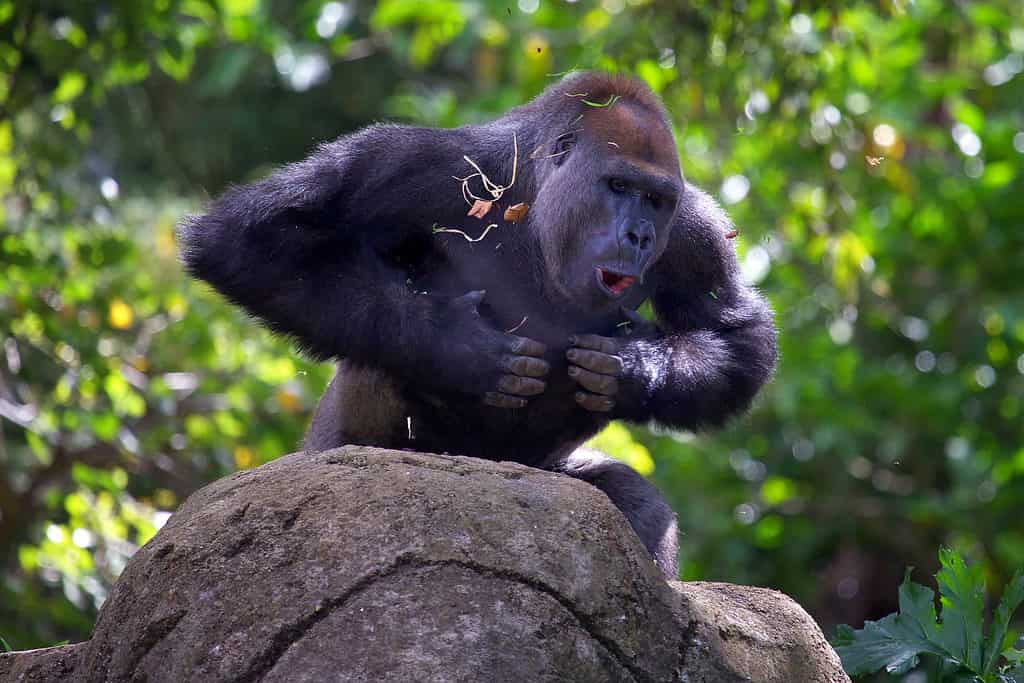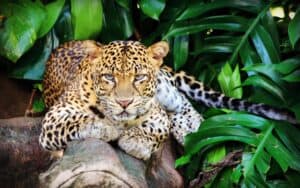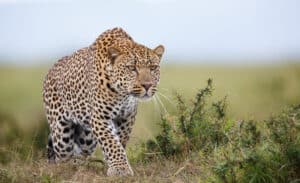The leopard is an accomplished, agile, and athletic hunter. They will exploit opportunities for hunting prey that larger and heavier big cats, like the tiger, cannot manage.
Leopards are world-leading experts when it comes to hunting in trees. Even though you may know this, you will still be amazed by this video — especially the last few seconds. It has already been watched over three and a half million times.
We see a leopard pursuing a monkey in the branches of a tree. They leap confidently among smaller and smaller branches despite the gasps from the human onlookers. A few times, it looks as if the leopard is going to fall and they take a lot of risks.
However, they are obviously confident in their ability to recover and are soon back to the pursuit. In a stunning finale, the leopard makes a death-defying leap to snatch the money in their jaws. As one of the onlookers exclaims “That is good!”
Leopards Hunting in Trees
Leopards are found across sub-Saharan Africa and southern Asia where they like to spend a lot of their time in the branches of trees. Their anatomy has a number of adaptions that allow them to move easily in this environment.
Their torso is long and slender and they have short legs but a long tail that they can use to balance in the branches. Their strong muscles allow them to climb quickly and their sharp claws grip the bark. However, they can retract those claws when they are walking on the ground which stops them from getting blunt.

Leopards can scope out their prey from a high vantage point.
©Hermis Haridas/Shutterstock.com
Hunting Monkeys
Leopards have excellent hearing and sight and sensitive whiskers so they are equipped to hunt at night even though this particular hunt was during daylight.
They are an ambush predator, which basically means that they sneak up on prey and then lunge at them. That is not quite what we see here – but you will certainly spot the lunge that takes the monkey by surprise.
As well as monkeys, leopards also hunt warthogs and deer and often do this from a tree! They will wait in the branches and then leap on the prey from above. Leopards also eat birds, rodents and reptiles and will not refuse a dung beetle if other food sources are not available.
At the other end of the scale, they are also strong enough to hunt antelopes but they will often drag their prey into trees where they can enjoy it in peace. Of course, when they catch a monkey in a tree, this will not be necessary.

Leopards prefer to feast on antelope and gazelles.
©Mohamed Hakem/Shutterstock.com
Do Leopards Normally Hunt Monkeys?
The short answer here is yes, radio tracking data research has shown that forest leopards primarily hunt for monkeys on the ground during the day time.
Faecal analyses has confirmed that monkeys account for a large portion of a leopards diet and revealed that they focus their hunting on eight different species of monkeys and one chimpanzee species.
Not only do leopards prey on monkeys, but they have also been known to take on adult male lowland gorillas, although it is rare.
Leopard vs Gorilla: Who Would Win in a Fight?
Just because a leopard takes on a gorilla, doesn’t mean it will win. Although it is most likely a successful outcome for the leopard due to the large cat’s attack speed.
In fact, in our article: Leopard vs Gorilla: Who Would Win in a Fight? we discuss how leopards are much faster than gorillas and this type of movement is difficult for gorillas and other primates to fight off.
A win for a gorilla would only happen if both animals were placed on equal footing at the gorilla was visually aware of an oncoming threat.
Additionally, gorillas are not apex predators whereas leopards are.
To summarize, in most cases, a leopard would win the fight against a gorilla.

Due to its speed, a leopard would likely win in a fight with a gorilla.
©iStock.com/hypergurl
Lifespan: How Long do Leopards Live?
There are about 250,000 leopards in existence today, and they are divided into nine different subspecies.
In the wild, the average lifespan of a leopard is about 12 to 17 years old. However, in captivity and treated properly, these large cats can live up to about 23 years old.

The average lifespan of a leopard is 12-17 years.
©iStock.com/UrmasPhotoCom
Leopards are able to live up to 17 years in their natural habitats in part because they are expert hunters on land and in trees. Watch the video to see a leopard leap into action when hunting a monkey!
Other Amazing Animal Videos You Might Like
While the leopard in the video above is confident in its abilities to hunt and catch the monkey, in the video below you can see the tables turned and a leopard is the one who ends up running scared from a baboon.
The video opens on the leopard perched up in a tree and the camera follows as it makes its way along a branch. We hear its prey before we see it: an angry baboon barking! Startled, the leopard turns away and then back again, but in a second the baboon aggressively enters the frame and confronts the cat.
The leopard makes a hasty retreat — too hasty as it loses its footing and is left hanging onto the branches as the baboon continues to make it very clear that it won’t be the leopard’s next meal. While striking with its paw to defend itself, the leopard slips from the branches, lands on the forest floor and escapes into the undergrowth. Watch this fascinating fight below!
Next Up:
Check out some of our other popular articles:
- Watch a Leopard Mess With the Wrong Porcupine!
- Watch A Leopard Come Out Of NOWHERE And Attack A Cyclist
- Watch: Python vs Leopard Face-Off In Kruger
The photo featured at the top of this post is © Pavith Malaka/Shutterstock.com
Thank you for reading! Have some feedback for us? Contact the AZ Animals editorial team.







